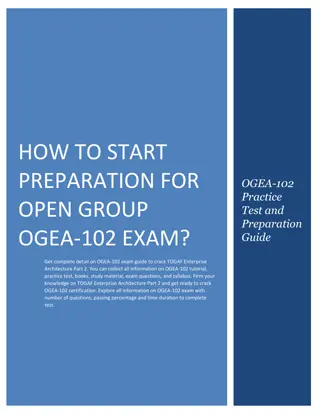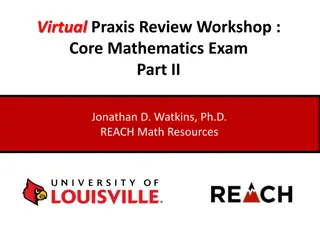Environmental Science Exam Review Part 1
This review covers topics related to environmental science such as chemical compounds, global protein production, environmental activists, significant events, and the greenhouse effect. It also includes illustrations and questions for better understanding and assessment.
Download Presentation

Please find below an Image/Link to download the presentation.
The content on the website is provided AS IS for your information and personal use only. It may not be sold, licensed, or shared on other websites without obtaining consent from the author.If you encounter any issues during the download, it is possible that the publisher has removed the file from their server.
You are allowed to download the files provided on this website for personal or commercial use, subject to the condition that they are used lawfully. All files are the property of their respective owners.
The content on the website is provided AS IS for your information and personal use only. It may not be sold, licensed, or shared on other websites without obtaining consent from the author.
E N D
Presentation Transcript
Exam Review Part 1
1. Name the following: NO ____ NO2 ____ NO2- ____ NO3- ____ NO2+ ____ N2O ____ N2 ____ NH3 ____ NH4+ ____ HNO3 ____ NOx ____ (produced by burning of ff) Nitric oxide Nitrogen dioxide Nitrate Nitrite ion Nitronium ion Nitrous oxide Ammonia Nitrogen gas Nitric acid Ammonia Nitrogen oxides
Summer sun Winter sun SOUTH
3. Use the information in the diagram on the left, to answer the following: a. The percent change in the per capita global production of protein 92% from poultry between 1980 and 2000 was approximately ________. 13 25 25-13=12 12/25=.92 b. The percent change in the per capita global production of protein 380% from farmed fish between 1980 and 2000 was approximately ________. c. The percent change in the per capita global production of protein 0% from beef between 1961 and 2009 was approximately ________.
4. The founder of the Sierra Club was ________ ________. 5. Rachel Carson wrote the book ________ Springto raise people s awareness of the harmful effects of the pesticide ________. 6. The acronym ENSO refers to _____________ _____________ _____________ _____________, a phenomenon that occurs in the _____________ ocean. Pacific John Muir Silent DDT El Nino/Southern Oscillation
1.Deepwater Horizon (2010) 2.Kyoto Protocol (1997) 3.Exxon Valdez (1989) 4.Montreal Protocol (1989) 5.Chernobyl (1986) 6.Bhopal (1984) 7.Love Canal (1978) 8.Endangered Species Act (1973) 9.Earth Day (1970)
Strengthen this weak statement: Fossil fuel use releases carbon dioxide, which causes the greenhouse effect. The burning of fossil fuels release CO2. When greenhouse gases (CO2, CH4, NO2, H2O) are struck by infrared radiation, the molecules vibrate and emit the radiation at a lower wavelength. These lower wavelengths remain trapped in the troposphere, trapping heat energy and raising average global temperatures.
9. The acronym BOD refers to Biological Oxygen Demand, which is the amount of dissolved oxygen needed by aerobic biological organisms (like bacteria) in a body of water to break down organic material present.
10. The acronym GMO refers to genetically modified organisms, which is any organism whose genetic material has been altered using genetic engineering techniques.
11. Perform the following calculation. Show all of your work. If the grasses on a 100-hectare area of grassland grow at an average rate of 1 cm/day, the average volume of grass that is added to the grassland each day is ____________ m3. If the density of the grasses that grow in the grassland averages 400 kg/m3, the net primary productivity is approximately _____________ g/m2/day or _____________ g/m2/year. Show work: 10,000 4,000 1,460,000 100 hectares x 10,000 m2 = 1,000,000 m2 x 0.01m = 10,000 m3/day 1 hectare day 1000g x 400kg x 10,000 m3 x _____1____ = 4,000 g/m2/day 1kg m3 1 day 1,000,000 m2
12. Strengthen this weak statement: Protecting endangered species like the Giant Panda costs too much and should be stopped. Biodiversity offers many benefits: products like food, medicines, fuel. It provides ecosystem services, and each individual plays specific roles in an ecosystem. More diverse ecosystems are more stable and more productive. The panda likely controls bamboo populations and should be preserved. The ecological benefits outweigh the monetary cost.
13. Perform the following calculation. Show all of your work. A 40 m2 solar array is installed on a house where the average insolation is 6 kWh/m2/day if the average total electricity output of the array is 1.2 kWh/hr, the efficiency of the array is ____________. 12% insolation = Amount of radiation that strikes a given location over a given period of time 6 kwh x 40m2 = 240kWh x 1day = 10kWh/h m2 day 24h Only 1.2 kWh out of 10 kWh is converted to electricity: 1.2/10 = 0.12 12% efficient
14. Consider the graph on the right and explain what can be inferred from the data it presents. The more women are educated and empowered, the fewer children they choose to have, lowering Total Fertility Rate of a country.
15. The first National Park was Yellowstone ________________ National Park. Match the ten most populous urban areas in the world with its respective continent: a. Asia Seoul, South Korea a b. N. America Mexico City b c. S. America NYC b d. Africa Mumbai, India a e. Australia Jakarta, Indonesia a f. Europe Sao Paulo, Brazil c g. Antarctica Delhi, India a Osaka/Kobe, Japan a Shanghai, China a Tokyo, Japan a
Watershed: Land area that delivers water, sediment, and dissolved substances via small streams to a major waterway (river) Clean Air Act: US federal law designed to control air pollution. Requires the EPA to develop and enforce regulations against airborn pollutants known to be hazardous to human health. Clean Water Act: The EPA is charged with implementing pollution control programs and ensuring water quality standards for surface waters. Does not groundwater, wells, artificial lakes.
El Nino: An irregularly-occurring and complex series of climactic changes affecting the equatorial Pacific region and beyond every few years. Tradewinds weaken or reverse, waters warm near SA and prevent upwelling, affecting marine food webs. Baghouse filter: Air pollution control device that removes particulates out of air or gas released from commercial processes or combustion for electricity generation.
Electrostatic precipitator: A device that removes suspended dust particles from a gas or exhaust by applying a high voltage electrostatic charge and collecting the particles on a charged plate. Dioxin: Toxic compound produced during combustion processes like waste incineration, forest fires, and backyard trash burning, as well as paper bleaching and herbicide manufacturing.
18. List three sources of methane that are amplified by human activities. 1. Cattle farms 2. Landfills 3. Natural gas and petroleum emissions
19. The box to the right contains a crude depiction of a mountain, use it to sketch and label the essential atributes of a rain shadow. Include labels for the direction of the prevailing winds and nearest ocean. Rainshadow effect: A dry area on the leeward side of a mountain. The mountain blocks the passage of rain, producing weather systems by forcing the prevailing winds upward, where it condenses and precipitates before it crosses the top. Warm moist air Rising air cools and condenses Dry air advances Rainshadow Prevailing wind Ocean Land
20. NO2 is converted to N2 and O2 in a _____________ _____, which also converts _____________ to ____________. hydrocarbons catalytic converter CO2 and H2O --Eliminate NOx and VOCs to lower photochemical smog
21. Explain the causes of an urban heat island. Impermeable surfaces (roads, buildings, etc.) replace porous natural surfaces. Sun can heat roads and asphalt much hotter than air temps. Increased levels of air pollutants (GHG) trap heat.


























